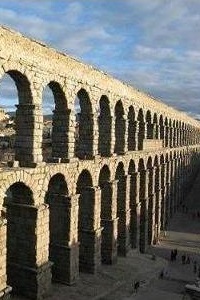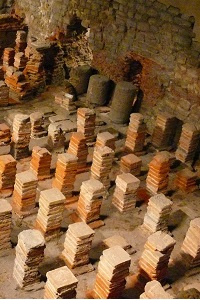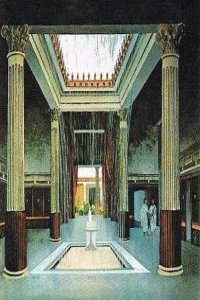Roman Baths: Architecture, Daily Life, and Enduring Legacy
Updated on: 22 September 2024Reading time: 5 minutes
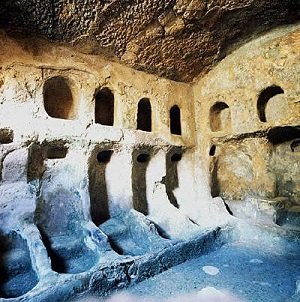
in Cyrene, Libya |
Roman baths were an integral part of Roman life. Unlike later periods (from the Dark Ages up until the 19th century), bathing was very common in ancient Rome. Most Romans, regardless of social class, would bathe often.
Roman baths followed the Greek tradition of bathing. The ancient Greeks had thermal complexes built on natural springs and carved into the rock, as they believed these springs had healing powers and would leave offerings to their gods. Greek bathhouses contained bathtubs and niches cut into the rock where bathers left their clothes. These facilities were beautifully decorated, and some have been found with stunning mosaics. However, the Romans elevated the art of bathhouse construction to another level.
How Romans Used to Bathe
Romans did not bathe the way we do today. For most, bathing was a public activity. Only the very wealthy could afford private bathing facilities and saunas in their villas. The Romans bathed in thermae, which were akin to modern-day saunas. These thermae were also social spaces where people gathered to relax, discuss business, court women, or simply socialise. Baths were an essential part of Roman daily life.
Bathing was not only for cleanliness but also for the health benefits of being in a sauna. Thermal complexes built on hot springs were believed to cure diseases or relieve pain. For example, elderly people with arthritis, those seeking weight loss, or even individuals recovering from hangovers after drinking too much wine would spend time in these ancient Roman saunas.
How Roman Baths Were Built
Romans emulated the Greeks but took the construction of Roman baths to an entirely new level. By the 4th century AD, the city of Rome boasted nearly 1,000 public baths! Roman baths were also built in forts for the army. Initially, most bathhouses were constructed on natural hot springs or tidal pools. However, with the introduction of aqueducts, Romans were able to build them everywhere. Water from the aqueducts was heated within the bathhouses. There were two types of Roman baths: the thermae, which were large, and the balneum, which were much smaller. The thermae were state-owned, while the balneum were typically privately owned. Both types charged a small entry fee, affordable to most Romans. Among the largest baths ever built by the Roman state were the Baths of Diocletian, constructed around 300 AD, which could hold up to 3,000 bathers, and the Baths of Caracalla, built around 215 AD.
How Romans Baths Looked and Functioned
Roman bathhouses featured a large symmetrical façade and multiple entrances, usually three. There was one entrance for men, another for women, and a separate one for slaves who worked at the facilities. Often, there was an open courtyard inside called the palaestra, surrounded by beautiful colonnades, used for exercise or swimming (as some contained a swimming pool).
As mentioned earlier, baths varied in size (thermae being larger, and balnea smaller), and the level of decoration ranged from simple to elaborate. Upon entering a Roman bathhouse, bathers would move from one room to another, gradually exposed to increasing temperatures. The visit would begin in the apodyterium, akin to a locker room. Next, they would move to the frigidarium, which contained cold (frigid) water. From there, they would proceed to the tepidarium, a warmer room, before reaching the caldarium, a very hot room. Some baths also had a laconium, a dry room used for resting.
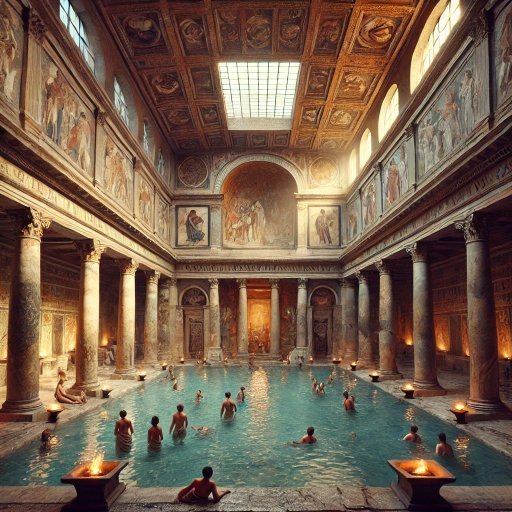
|
Beneath the hot rooms, there was a hollow floor where fires would burn. Inside the caldarium, there were also pools of cold water used by bathers to cool down. After the caldarium, the bather would return to the tepidarium for a massage and cleaning. In fact, cleaning was not done by showering but by scraping the skin with a metal instrument. Romans typically covered their bodies in oil during the massage, and then scraped the oil off their skin with a metal tool.
Roman baths often included large libraries where Romans could read, as well as rooms that served food. There were even small shops set up to sell perfumes, which were used after scraping the oil from the body. The courtyard was usually used for exercise, and there were also rooms functioning as gymnasiums.
Roman baths were beautifully decorated. Inside, there were many stunning statues and fountains. The floors and walls were often covered with marble and adorned with intricate mosaics, depicting trees or animals. Many baths had domes painted blue to resemble the sky.
Separation of Men and Women
Roman baths originally separated men and women. During the Republic, the baths were divided by a wall, with the women’s section typically smaller than the men’s. During the Empire, it became common for bathhouses to be mixed. Some associate this with the moral decline of the Roman Empire. It is said, though not confirmed, that Emperor Hadrian banned mixed baths, but the ban did not last long after his death.
Demise
Most bathhouses in Rome remained functional until the Gothic invasions in the early 6th century AD, which led to the destruction of the aqueducts and the downfall of these facilities.
|
Where you can visit Greek and Roman baths
There are many places where you can still see ruins of ancient Roman baths. Below is a list of locations along with some information about each. We will continue to add more locations and details in the future, so make sure to visit the site often:
|
